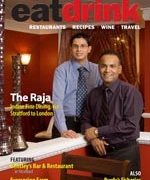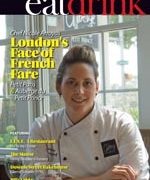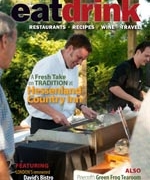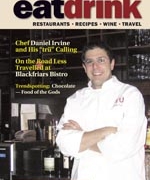Eating Toronto
As Ontarians, are we supposed to take pride in or offence to the nickname of Hogtown for our provincial capital? What are we supposed to think about that section of the city known as Cabbagetown? Is there any deep meaning behind these blatant food references? Editors Christina Palassio and Alana Wilcox have compiled a collection of food essays in The Edible City: Toronto’s Food From Farm to Fork to not only explain how food defines Toronto’s history, but also how a city feeds its citizens and how those citizens can make the best food choices to keep a city sustainable. The book presents dozens of Toronto writers tackling a variety of current topics, such as the debate over opening up street food to healthier offerings other than hot dogs, legislation to protect agricultural land, school meal programs, immigrant workers in Ontario farms, food banks, humanitarian programs to feed the hungry, and food-related activist projects.
As for the city’s pet name, “We can thank the humble pork-packing business for the ‘hog’ in Hogtown” one essayist writes, making reference to the successful pork industry started in the 1800s that lead Toronto to become the second largest food-processing city in North America (after Chicago). And the cabbage moniker comes from the 1800s as well when “urban vegetable gardening began to be viewed as faintly suspect, and there is more than a whiff of class prejudice in the legendary naming of Cabbagetown after the cabbages that were said to be grown in front yards by the very poor.” Other sections of Toronto are called Don Mills and York Mills after the flour mills that operated there and many neighbourhoods can be defined by the food business and the smells that waft from their factories like Redpath sugar, Campbell’s soup, Weston bread, and Neilson chocolate. As one writer says, “It would be difficult to identify a city block in downtown Toronto that has never been used to grow food.” All land across our province was once something else more fertile and productive before becoming a city.
City nicknames aside, a common thread throughout the book is how Torontonians can connect with healthy and sustainable food and there is a wide variety of essays including such topics as: the history of the vegetarian movement in Toronto; restaurant chefs working more closely with local suppliers; the practical and financial cost to the average household of buying organic, artisanal food instead of mass-produced; the rise of “the independent café culture of the city, slowly extending its tendrils in the past few years to blossom beyond niche nerdism into viable neighbourhood strongholds, so much more Torontonian than anything a big-box corporate café could serve up,” and a similar uprising in craft beer. Many of the essays refer to the theme of food security defined by the UN’s Food and Agriculture Organization as “when all people, at all times, have physical and economic access to sufficient, safe and nutritious food to meet their dietary needs and food preferences for an active and healthy life.” Going further back in history, no doubt foraging, hunting, fishing, and farming were the sources of food. Ice fishing on Lake Ontario may be a sport these days, but in the 1800s it was a form of sustenance in the cold winters, and even salmon was caught in Toronto’s rivers at one time. The food from these historical activities are represented in the two most famous modern day markets, St. Lawrence and Kensington, along with 54 smaller ones throughout the GTA. Fresh food is looked at in personal essays by writers picking peaches in Niagara and searching for the best (albeit possibly illegal) eggs in Toronto’s markets.
The book also brings to light that Toronto is home to nearly every other culture around the world. The assembly of international cuisine in such a diverse restaurant scene in one city cannot be matched. Essays in this realm include childhood visits to Toronto’s best Hungarian restaurants, one writer’s love of Roti, and the rise of Asian fusion. Another claim to fame of the city is that there is even a cocktail named after Toronto, even though the investigative efforts of one writer fail to prove why Toronto the drink is linked to Toronto the city. The only conclusion he can draw is that “if the Manhattan is world-famous and imbued with the classy, cosmopolitan, urbane character of is namesake city, then the Toronto is its homely (but oddly seductive) cousin, existing in relative obscurity, strange tasting and difficult to recommend.”
Anyone from Toronto, or even those who spend the occasional weekend there, will recognize the landmarks, restaurants, parks, and streets mentioned in the book and immediately feel a sense of connection with this food revolution. The Edible City suggests that Toronto is a food Mecca because it is surrounded by farmland and vast water resources and, even though the book is esoteric to Toronto, it is not difficult to make it applicable to any Ontario city because these characteristics are shared with urban centres across the province. If our country’s largest metropolis can pull off fruit trees in public parks, sustainable urban farms on city blocks, and apiaries on hotel rooftops, then surely every smaller city across Ontario can too.
More importantly, these essays give inspiration for revolution on an individual basis for those who care about what they eat, how they feed their families, and how cities will be food secure in the future. As one writer puts it: “I think the special taste of a food movement comes from empowerment. The direct and unmediated connection between humans and food means food is more amenable to direct action by individuals or groups than any sector of the economy. At any given time, people can choose to give up sugar in their coffee, go for soy milk instead of cream, skip meat for one day a week, pay a little more for fair-trade chocolate and so on.” Food may be a global commodity but it is easy to make choices to help de-globalize and re-localize a city’s food supply.











